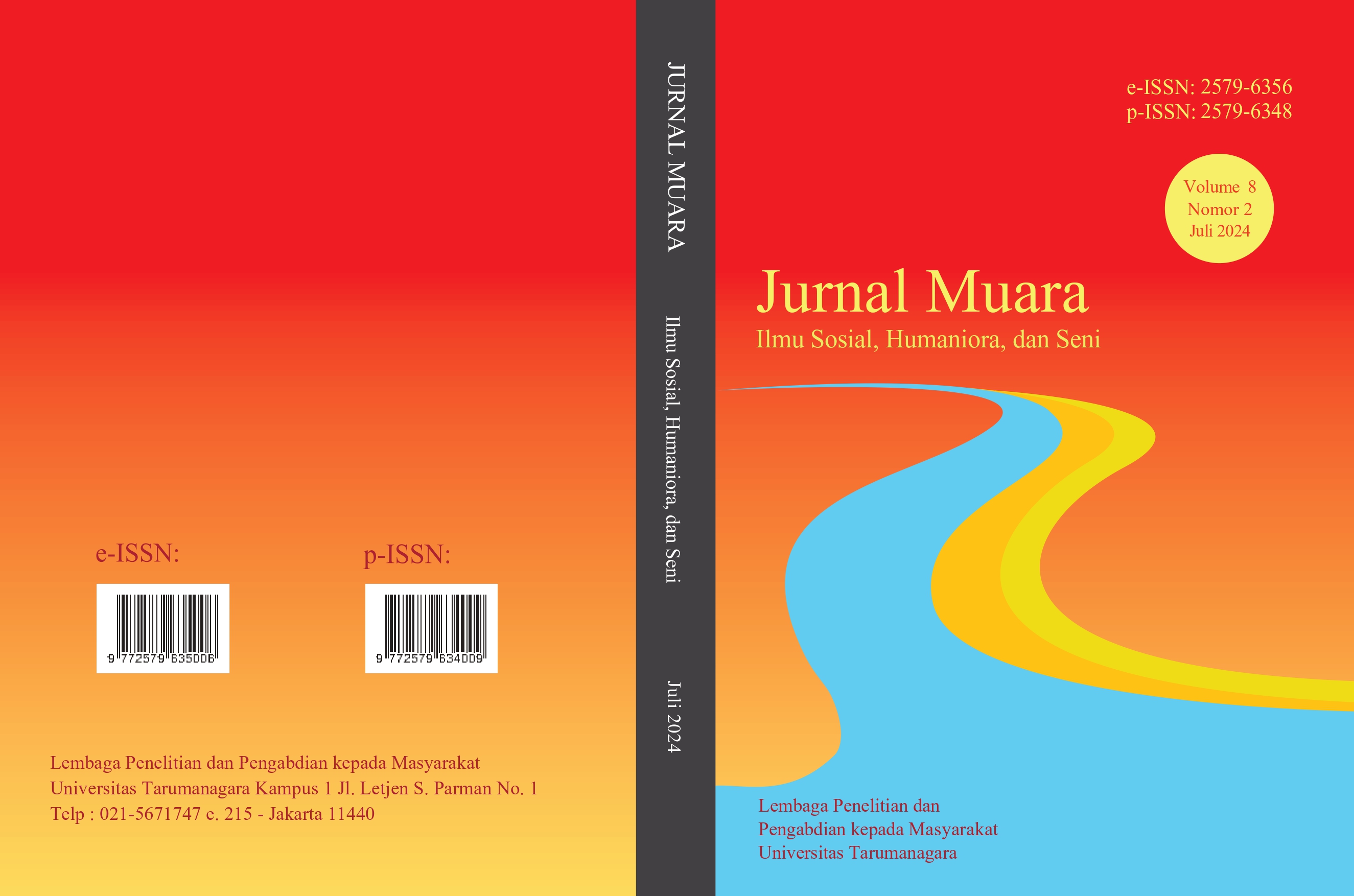HUBUNGAN ART-INDUCED AWE SEBAGAI DENGAN PERILAKU PROSOSIAL REMAJA
Main Article Content
Abstract
Keberhasilan untuk mengembangkan perilaku prososial pada remaja telah dikaitkan dengan peningkatan self-esteem, prestasi akademik, sense of happiness, dan hubungan sosial berkualitas di saat dewasa. Seiring berkembangnya zaman perilaku prososial pada remaja tidak meningkat namun cenderung menurun. The broaden and build theory menyatakan bahwa emosi positif mampu untuk memperluas perhatian individu termasuk kepada lingkungan sekitar yang diteorikan dapat meningkatkan perilaku prososial. Salah satu emosi positif yang memiliki kemampuan ini adalah awe, khususnya yang dipicu oleh objek seni. Penelitian ini bertujuan untuk mengetahui hubungan antara art-induced awe dengan perilaku prososial remaja di Indonesia. Penelitian ini melibatkan 397 remaja dengan 373 data yang sesuai karakteristik untuk diolah menggunakan non-probability sampling. Alat ukur yang digunakan dalam penelitian untuk mengukur variabel Art-Induced Awe yaitu The Dispositional Positive Emotions Scale (DPS-Awe) yang telah diadaptasi oleh peneliti. Adapun alat ukur yang digunakan untuk mengukur variabel perilaku prososial yaitu skala perilaku prososial yang diadaptasi oleh Fakultas Psikologi Universitas Tarumanagara. Uji korelasi pada penelitian ini menggunakan Spearman rho dan didapatkan hasil r=:0,306 dan p <0.05. Dapat disimpulkan bahwa terdapat hubungan signifikan yang positif antara art-induced awe dengan perilaku prososial pada remaja di Indonesia.
Article Details

This work is licensed under a Creative Commons Attribution-NonCommercial-ShareAlike 4.0 International License.
This work is licensed under a Jurnal Muara Ilmu Sosial, Humaniora, dan Seni Creative Commons Attribution-ShareAlike 4.0 International License.References
Baron, R. A., dan Byrne, D. (2005). Psikologi Sosial. Erlangga.
Compton, W. C., & Hoffman, E.. (2013). Positive Psychology: The Science of Happiness and Flourishing (Second). Cengage Learning.
Crone, E. A., & Achterberg, M. (2022). Prosocial development in adolescence. Current Opinion in Psychology, 44, 220–225. https://doi.org/10.1016/j.copsyc.2021.09.020
Eisenberg, N., & Spinrad, T. L. (2016). Multidimensionality of pro- social behavior: Rethinking the conceptualization and development of prosocial behavior. In Prosocial Development: A multidimensional approach (pp. 17–39). essay, Oxford University Press.
Eisenberg, Nancy, & Mussen, P. H. (1989). The roots of prosocial behavior in children. Cambridge University.
Eisenberg, Nancy, Damon, W., & Lerner, R. M. (2006). Handbook of Child Psychology. John Wiley & Sons.
Eisenberg, Nancy, Fabes, R. A., Karbon, M., Murphy, B. C., Wosinski, M., Polazzi, L., Carlo, G., & Juhnke, C. (1996). The relations of children’s Dispositional Prosocial behavior to emotionality, regulation, and social functioning. Child Development, 67(3), 974. https://doi.org/10.2307/1131874
Fredrickson, B. L. (2001). The role of Positive Emotions in Positive Psychology: The Broaden-and-build theory of positive emotions. American Psychologist, 56(3), 218–226. https://doi.org/10.1037/0003-066x.56.3.218
Fredrickson, B. L. (2013). Positive emotions broaden and build. Advances in Experimental Social Psychology, 1–53. https://doi.org/10.1016/b978-0-12-407236-7.00001-2
Fu, W., Wang, C., Chai, H., & Xue, R. (2022). Examining the relationship of empathy, social support, and Prosocial Behavior of adolescents in China: A structural equation modeling approach. Humanities and Social Sciences Communications, 9(1). https://doi.org/10.1057/s41599-022-01296-0
Keltner, D., & Haidt, J. (2003). Approaching awe, a moral, spiritual, and aesthetic emotion. Cognition and Emotion, 17(2), 297–314. https://doi.org/10.1080/02699930302297
Law, M., Karulkar, N., & Broadbent, E. (2021). Evidence for the effects of viewing visual artworks on stress outcomes: A scoping review. BMJ Open, 11(6). https://doi.org/10.1136/bmjopen-2020-043549
Li, J.-J., Dou, K., Wang, Y.-J., & Nie, Y.-G. (2019). Why awe promotes prosocial behaviors? the mediating effects of future time perspective and self-transcendence meaning of life. Frontiers in Psychology, 10. https://doi.org/10.3389/fpsyg.2019.01140
Papalia, D. E., Olds, S. W., & Feldman, R. D. (2009). Human development. McGraw-Hill.
Piff, P. K., Dietze, P., Feinberg, M., Stancato, D. M., & Keltner, D. (2015). Awe, the small self, and prosocial behavior. Journal of Personality and Social Psychology, 108(6), 883–899. https://doi.org/10.1037/pspi0000018
Sawyer, S. M., Azzopardi, P. S., Wickremarathne, D., & Patton, G. C. (2018). The age of adolescence. The Lancet Child & Adolescent Health, 2(3), 223–228. https://doi.org/10.1016/s2352-4642(18)30022-1
Shiota, M. N. (2021). Awe, wonder, and the human mind. Annals of the New York Academy of Sciences, 1501(1), 85–89. https://doi.org/10.1111/nyas.14588
Shiota, M. N., Keltner, D., & John, O. P. (2006). Positive emotion dispositions differentially associated with big five personality and attachment style. The Journal of Positive Psychology, 1(2), 61–71. https://doi.org/10.1080/17439760500510833
Stamkou, E., Brummelman, E., Dunham, R., Nikolic, M., & Keltner, D. (2023). Awe sparks prosociality in children. Psychological Science, 34(4), 455–467. https://doi.org/10.1177/09567976221150616
Sutomo, R., Ramadhani, F. P., & Hanifa, I. N. (2022). Prevalence and associated factors of psychosocial and behavioral problems in Indonesian adolescent students during the COVID-19 pandemic. Frontiers in Pediatrics, 10. Valdesolo, P., & Graham, J. (2014). Awe, uncertainty, and agency detection. Psychological Science, 25, 170–178.
Van Lange, P. A. M., Joireman, J., Parks, C. D., & Van Dijk, E. (2013). The Psychology of Social Dilemmas: A Review. Organizational Behavior and Human Decision Processes, 120(2), 125–141. https://doi.org/10.1016/j.obhdp.2012.11.003


